

Perfectly preserved 6,000-year-old leaf that fell from elm tree discovered by archaeologists. A leaf that fell from an elm tree more than 6,000 years ago was discovered intact by archaeologists in the United Kingdom.
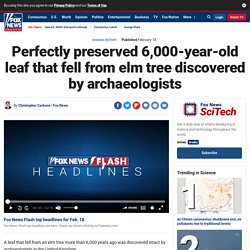
Scientists found the leaf -- along with a selection of Stone Age tools and pottery -- when they were clearing a piece of land outside of Blackpool along the coast of northern England. Lead archaeologist Fraser Brown told The Daily Mail that the finds were of national significance. A perfectly-preserved leaf (seen above) that fell from an elm tree 6,000 years ago has been discovered intact. (Highways England/SWNS) "We have found extensive deposits of peat and marine clays which have helped preserve ancient plant remains and which yield information on the local vegetation, water, climate, and human activity," he explained to the British publication. Rare pottery and tool fragments found at the site include (on the left) parts of a Carinated Bowl. Israeli swimmer's discovery of Egyptian artifact met with suspicion in Cairo. Feb 14, 2020 CAIRO — An archaeological discovery does not always require months and years of research, imaging sonar or magnetometric scanning, drilling or sophisticated excavation tools.

Occasionally, a passerby stumbles upon an artifact, just as an Israeli veterinarian claims he did, though some Egyptian experts claim that the whole story is a sham and the artifact was actually smuggled from Egypt. Israeli Haaretz newspaper reported Feb. 4 that Rafi Bahalul stumbled upon a 3,400-year-old Egyptian stone anchor engraved with hieroglyphs during a morning swim along Israel’s northern shores last year.
The Israel Antiquities Authority said that the artifact is a granite stone depicting the ancient goddess Sechat. The hieroglyphs on the anchor date back to the 18th dynasty of Egypt (1550-1292 B.C.). Experts quoted by the Israeli daily speculated that the piece may be part of a mural decorating a temple or a royal palace. En.m.wikipedia. Human settlement In popular culture[edit] Letopolis is depicted in the 2017 video game Assassin's Creed Origins,[5] set during the Ptolemaic Era of Egypt.[6] References[edit]
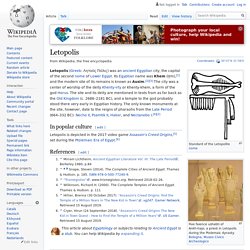
Intriguing Burials, Artifacts Unearthed at Ancient Egyptian/Nubian Site – National Geographic Society Newsroom. National Geographic explorers Michele Buzon and Stuart Tyson Smith are co-directors at Tombos, an archaeological site located at the Third Cataract of the Nile River in modern-day Sudan.
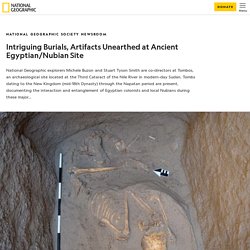
Tombs dating to the New Kingdom (mid-18th Dynasty) through the Napatan period are present, documenting the interaction and entanglement of Egyptian colonists and local Nubians during these major sociopolitical changes in the region. By Michele Buzon Our investigations into understanding life and death for the elite individuals buried in the Tombos pyramid/chapel structures at Tombos have been very successful this season. The focus on two large tombs has uncovered a wealth of interesting grave goods. Antarctica's biggest glacier still losing ice, thinning in a new way. Dinosaurs literally walked on fire — study.
From what we know about early Earth, dinosaurs put up with some wild circumstances — toxic plants, underwater magma, and that's before the asteroid that ultimately wiped them out.

And to thrive in these intense conditions, they evolved some nifty skills — like the ability to walk on fire. A few dozen fossilized footprints reveal that a group of dinosaurs were still kicking when the Karoo Basin, a region in South Africa, began to fill up with lava some 183 million years ago. The study, led by University of Cape Town geology professor Emese Bordy, was published Wednesday in the journal PLOS ONE.
Before now, researchers had no idea that dinosaurs and therapsids, the creatures from which mammals evolved, had managed to survive the moment when lava began to flood their habitat, turning it into a “land of fire.” Diary from World War I discovered in barn, recounts bloody Battle of the Somme. 'War to end all wars': How World War I still resonates today As the world marks the 100th anniversary of the armistice that ended World War I, the National World War I Museum and Memorial serves as a reminder of the sacrifices U.S. troops made in 'The Great War.' Eric Shawn reports from Kansas City, Missouri.

A British soldier’s battered World War I diary recounting the bloody Battle of the Somme has been discovered in a U.K. barn. The diary, which was written in pencil by Private Arthur Edward Diggens of the Royal Engineers, starts on Feb.13, 1916 and ends on Oct. 11 of that year. Neanderthal Genes Hint at Much Earlier Human Migration From Africa. In recent years, millions of people have been astonished, even thrilled, to learn from those popular genetic tests that their DNA is laced with Neanderthal genes.

Those genes were first discovered in 2010, in a study of Neanderthal fossils. From DNA recovered from the bones, researchers deduced that modern humans interbred with Neanderthals some 60,000 years ago, after leaving Africa. As a result, the genes of non-Africans today are 1 percent to 2 percent Neanderthal. People of African ancestry, it was thought, have little to no Neanderthal DNA.
Using a new method to analyze DNA, however, a team of scientists has found evidence that significantly reshapes that narrative. Mummies of ancient Egyptian priests found buried with thousands of afterlife 'servants' A massive burial ground holding the remains of several high priests of ancient Egypt, along with their assistants, has been discovered in the northern part of the site of Tuna el-Gebel, Egypt's antiquities ministry announced Thursday (Jan. 30).
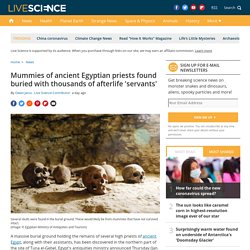
So far, the archaeologists have unearthed 20 stone sarcophagi (coffins) made of a "very good quality of limestone" in the burial ground, which lies about 170 miles (270 kilometers) south of Cairo, said Mostafa Waziri, the general secretary of Egypt's Supreme Council of Antiquities, during a news briefing. In addition, the burials together contained some 700 amulets, some made of gold or precious stones, along with more than 10,000 shabti figurines made of faience (a glazed ceramic), Waziri said. The ancient Egyptians believed that shabti figurines served the deceased in the afterlife. Related: See Photos of the "Cachette of the Priests" from Luxor. Ancient Egypt's City of the Dead: Amulets, Sarcophagi, Canopic Vases and Priestly Tombs of the God Thoth. Digs in Egypt's City of the Dead have unearthed a hoard of ancient artefacts, including amulets, canopic vases and 16 tombs containing approximately 20 coffins and sarcophagi between them.
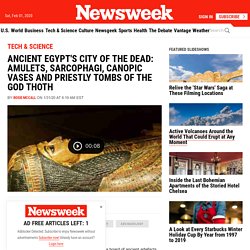
Amongst the finds are tombs belonging to high priests of the God Thoth. The news was announced by Egypt's Ministry of Antiquities on Thursday amid ongoing excavations at Tuna el-Gebel—an archaeological site approximately 270 kilometers (167 miles) south of Cairo, nicknamed the City of the Dead. The site contains Ancient Egyptian buildings, with some of the oldest dating back to the early Ptolemaic Period, around 300 BCE. These include a temple belonging to the God Thoth, a bird-like deity responsible for writing, accounting and all other intellectual pursuits. The necropolis at Tuna el-Gebel also features an expansive underground network of galleries where the research team says various types of animals have been buried. Shocking truth behind Takabuti’s death revealed.
- Advertisement - Takabuti, the famous ancient Egyptian mummy on display at the Ulster Museum, suffered a violent death from a knife attack, a team of experts from National Museums NI, University of Manchester, Queen’s University Belfast and Kingsbridge Private Hospital have revealed.
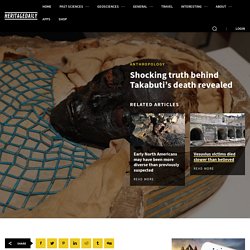
The team, whose findings are made public on the 185 year anniversary of Takabuti’s unwrapping in 1835, also show that her DNA is more genetically similar to Europeans rather than modern Egyptian populations. Fait désormais partie dâVerizon Media. TUNA AL-GABAL, Egypt (AP) — Archaeologists on Thursday unveiled 16 ancient Egyptian tombs filled with sarcophagi and other artifacts from a vast burial ground. Egypt’s Antiquities Ministry announced the discoveries in the village of Tuna al-Gabal, near the Nile Valley city of Minya in central Egypt. The site boasts an array of previously excavated finds, including funerary buildings and catacombs filled with thousands of mummified ibis and baboon birds. The long-abandoned tombs date back to three dynasties, from 664-399 BC, in the Pharaonic Late Period. Among the new treasures presented: 20 sarcophagi made from limestone and etched with hieroglyphic texts, five wooden coffins, hundreds of amulets and 10,000 blue funerary statues, known as ushabti figurines, which are fixtures in the ancient tombs of the area.
The sarcophagus lids are molded into mummy-like figures of men. The Egyptian government frequently promotes archaeological finds to boost its vital tourism sector. Sarcophagus dedicated to sky god among latest ancient Egypt trove. Ancient skulls from Mexico surprisingly diverse. By Natalie Parletta Analysis of four ancient skulls retrieved from the submerged caves of Quintana Roo, Mexico, suggests that early humans populating North America were far more diverse than previously thought. The discovery adds fresh fuel to one of the most hotly debated topics in archaeology and biological anthropology, according to a paper published in the journal PLOS ONE, as part of a quest to understand the origins of Native Americans. The skeletons, discovered by underwater archaeologists in the expansive limestone cave system that used to be above sea level, are dated to between 13 and nine thousand years ago, during the late Pleistocene/early Holocene.
New Building Found at Epidaurus' Asclepieion in Sensational Archaeological Discovery. 1108 32Google +0 0 2 1266 The Asclepieion of Epidaurus on the Peloponnesian Peninsula is one of the most important ancient sites in the entire world. Today, it owes a great deal of its fame to the theater, a wonder of acoustics which is still in operation today, but in ancient times it served as a medical sanctuary, and serious illnesses were healed there. People from all over the Eastern Mediterranean region flocked to Epidaurus in antiquity to find cures for their various maladies.
It was a spacious resort which included guesthouses, a gymnasium, a stadium and the famous theater, which served to “elevate the soul,” which ancient Greeks saw as the goal of all theatrical plays, both tragedies and comedies. Along with its many luxurious facilities, the Asclepieion of Epidaurus offered beautiful, serene natural surroundings, with lush vegetation and stunning views of the surrounding mountaintops.
“When it was decided to build the Tholos, this building was demolished. Stone tools reveal epic trek of nomadic Neanderthals. Their intercontinental odyssey over thousands of kilometres is a rarely observed case of long-distance dispersal in the Palaeolithic, and highlights the value of stone tools as culturally informative markers of ancient population movements. Environmental reconstructions from the animal and plant remains at Chagyrskaya Cave suggest that the Neanderthal inhabitants survived in the cold, dry and treeless environment by hunting bison and horses on the steppe or tundra-steppe landscape.
Our discoveries reinforce the emerging view of Neanderthals as creative and intelligent people who were skilled survivors. If this was the case, it makes their extinction across Eurasia even more mysterious. Did modern humans deal the fatal blow? Early North Americans may have been more diverse than previously suspected. An analysis of four ancient skulls found in Mexico suggests that the first humans to settle in North America were more biologically diverse than scientists had previously believed. The skulls were from individuals who lived 9,000 to 13,000 years ago, in the late Pleistocene and early Holocene eras. These findings complicate the story accepted until now, based on ancient skeletons analyzed from South America, which suggested the first settlers in the Americas were very similar, said Mark Hubbe, co-lead author of the study and professor of anthropology at The Ohio State University.
"The first Americans were much more complex, much more diverse than we thought," Hubbe said. Archeology doesn’t belong in the past, says Israeli expert - ISRAEL21c. Once upon a time, archeology was very much the realm of history buffs and dusty shovels. Fast forward to 2020, however, and you’ll find DNA testing and questions of climate change leading the field. Siberian Neanderthals were intrepid nomads. A new study, published online today in the Proceedings of the National Academy of Sciences, reveals that Neanderthals made an intercontinental trek of more than 3000 km to reach Siberia's Altai Mountains, equipped with a distinctive toolkit used to kill and butcher bison and horses. Neanderthals are our nearest evolutionary cousins and survived until around 40,000 years ago in western Europe. A squid fossil offers a rare record of pterosaur feeding behavior.
Incredible Dinosaur Fossil Reveals How Their Feathers Compared to Modern Birds. A 120 million-year-old fossil is helping paleontologists bridge the 'phantom' evolutionary leap between feathered dinosaurs and modern birds. Late Neolithic Italy was home to complex networks of metal exchange. Ancient site still has much to reveal. Dentist collecting ancient artifacts for 25 years. An Empyrean Whisper: The Fate of the Mysterious Minoans. New species of Allosaurus discovered in Utah. Civil War-era 'witch bottle' may have been found on US highway, archaeologists say. Oxus Treasure. Ancient rock carvings show procession of gods riding mythical animals. Geologists Confirm a Staggering 2.2 Billion-Year-Old Impact Crater in Australia. How Did Humans Come to the Americas? Archaeology latest: Secrets of ancient Peruvian artefact revealed by scientists.
Feathers on a newly discovered dinosaur are showing the difference from birds. Blocked page - Haaretz - Israel News. Egypt breakthrough: How ‘exceptional discovery’ in untouched tomb stunned archaeologist. Archaeology news: 3,500-year-old ‘entrance to another world' uncovered near Peterborough. Archaeology news: 3,500-year-old ‘entrance to another world' uncovered near Peterborough. Meteorite or Volcano? New Clues to the Dinosaurs’ Demise. The aquatic Neanderthal: They could swim and dive for clams - Archaeology. Secrets of 'Iconic' Ancient Peruvian Artifact Unravelled by Scientists. Ancient Viking Rok Runestone Warns Of Climate Crisis, Study Says.
Ancient Viking Rok Runestone Warns Of Climate Crisis, Study Says. Evidence of Recycling From 3,000 Years Ago Discovered at Site of Ancient Civilization in Middle East. Archaeology news: Hundreds of Chinese Terracotta Warriors unearthed in mammoth discovery. Geologists Baffled By “Massive Anomalies” at Edge of Earth’s Core. Archaeology news: ‘Britain’s most exciting’ mystery solved after 4,000 years. Ancient Egypt news: Scientists stunned as 4,000-year-old book find creates history. Archaeology shock: Scientists find 2,000-year-old market to rewrite Jerusalem's history. Evidence of Recycling From 3,000 Years Ago Discovered at Site of Ancient Civilization in Middle East. Mystifying Puzzle of Early Neolithic House Orientations Finally Solved. Evidence of Recycling From 3,000 Years Ago Discovered at Site of Ancient Civilization in Middle East. Archaeology shock: Scientists find 2,000-year-old market to rewrite Jerusalem's history.
Unusual Roman-era graves discovered in UK by archaeologists. Hundreds More Terracotta Warriors Unearthed at Tomb of China's First Emperor. Archaeology news: How 'treasures of Apollo’ were found buried below ancient Greek ruins. Viking runestone linked to fears of climate change: study. Archaeologists find graves of high-status Romans in Somerset. China's Terracotta Army grows as 200 MORE 'warriors' found in city of the dead. Scottish archaeologists find new megalithic rock structure on the Isle of Lewis. - The Washington Post. Hundreds More Terracotta Warriors Unearthed at Tomb of China's First Emperor.
Animal Bones Reveal Huge Feasts at Ancient Capital of Ulster Drew Crowds From Across Iron Age Ireland. Archaeologists Have Discovered the World's Oldest Illustrated Book in an Ancient Egyptian Burial Site. Prehistoric Monument May Have Intentionally Attracted Lightning. Egypt: ’Astonishingly rare’ discovery in Tutankhamun’s burial chamber exposes shock plot. Nypost. Discovery of iron anchors raises hopes of finding Hernán Cortés's ships. Archaeological discoveries are happening faster than ever before, helping refine the human story.
Egypt exposed: Why archaeologists were ‘terrified by lifelike discovery’ hidden in Pyramid. Archeology latest: Ancient graves found in Bulgarian site. Archaeology news: How bizarre ‘entranceway’ was discovered hidden in Incan ruins. Bronze Age royal tombs unearthed in Greece. Bronze Age royal tombs unearthed in Greece. Ancient wonders: five little-known archaeological sites in the UK. Discovery of iron anchors raises hopes of finding Hernán Cortés's ships. Archaeology breakthrough: How workers stumbled upon ‘mysterious’ 500-year-old Aztec stone Greece's Parthenon temple has had the wrong name for centuries, new research by archeologists claims Bronze Age royal tombs unearthed in Greece. Ancient Egyptian woman believed to be world's first female doctor did not exist, study says. Archaeology news: How ‘most important modern discovery’ was made in lost Mayan city. Archaeology breakthrough: How workers stumbled upon ‘mysterious’ 500-year-old Aztec stone
Archaeology shock: Scientists stunned after finding ‘rarest archaeological discoveries’ in. Egypt mystery: Archaeologist exposes ‘unexpected anomalies’ found in Tutankhamun’s tomb. Ancient Egypt breakthrough: Scientists find first evidence of ‘Head Cones’ in tomb. Ancient wonders: five little-known archaeological sites in the UK. Head Cones in Ancient Egyptian Graves Cap Archaeological Debate. Indonesian Cave Art Demands Human Cultural Evolution Overhaul. 'Lost' ancient town uncovered in Ethiopia was once part of the powerful Aksum empire. Giant pyramid-shaped asteroid to shoot past earth in hours. Aerial radar turns up a Viking ship in a farmer’s field. A chef uncovers the secrets of umami. Cuneiform Tablets and ‘Envelopes’ Tell of Mesopotamian Sophistication. Early humans domesticated themselves, new genetic evidence suggests.
Site of Ancient Egypt's Sun Cult Reveals Royal Statues, Mud Wall and Block of King Ramses II. Mayan mystery: How 1,000-year-old 'untouched' cave discovery left archaeologist speechless. Rare Ancient Tomb of Rich Minoan Woman Discovered at Monumental Archaeological Complex in Crete. DNA study sheds new light on the people of the Neolithic Battle Axe Culture. Ancient 'New York' discovered in Israel as archaeologists uncover lost Bronze Age city. Online Map Leads Archaeologist to Maya Discovery. 's Curiosity Rover Finds an Ancient Oasis on Mars.